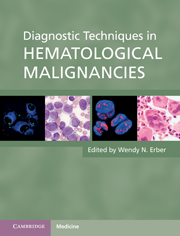Book contents
- Frontmatter
- Contents
- List of Contributors
- Preface
- Part 1 Diagnostic techniques
- Part 2 Hematological malignancies
- 6 The integrated approach to the diagnosis of hematological malignancies
- 7 Acute lymphoblastic leukemia
- 8 Acute myeloid leukemia
- 9 Mature B-cell leukemias
- 10 Mature T-cell and natural-killer cell leukemias
- 11 Lymphoma
- 12 Plasma cell neoplasms
- 13 Chronic myeloid leukemia
- 14 Myeloproliferative neoplasms
- 15 Myelodysplastic syndromes and myelodysplastic/myeloproliferative neoplasms
- Index
- References
12 - Plasma cell neoplasms
from Part 2 - Hematological malignancies
Published online by Cambridge University Press: 06 December 2010
- Frontmatter
- Contents
- List of Contributors
- Preface
- Part 1 Diagnostic techniques
- Part 2 Hematological malignancies
- 6 The integrated approach to the diagnosis of hematological malignancies
- 7 Acute lymphoblastic leukemia
- 8 Acute myeloid leukemia
- 9 Mature B-cell leukemias
- 10 Mature T-cell and natural-killer cell leukemias
- 11 Lymphoma
- 12 Plasma cell neoplasms
- 13 Chronic myeloid leukemia
- 14 Myeloproliferative neoplasms
- 15 Myelodysplastic syndromes and myelodysplastic/myeloproliferative neoplasms
- Index
- References
Summary
Introduction
Plasma cell neoplasms result from the clonal expansion of terminally differentiated B-cells that have the capacity to secrete a monoclonal immunoglobulin (Ig). This chapter will discuss the appropriate use of diagnostic techniques in the diagnosis and assessment of multiple myeloma, monoclonal gammopathy of undetermined significance, smoldering myeloma, plasma cell leukemia and Waldenström macroglobulinemia.
Multiple myeloma
Multiple myeloma (MM) is a plasma cell malignancy characterized by the proliferation of plasma cells (PC), mostly within the bone marrow (BM). The disease peaks in incidence in the seventh decade of life. While still considered an incurable diagnosis for most patients, patients are surviving longer due to the availability of new treatments. In a subset of patients, mostly those treated with more aggressive interventions such as combinations of novel agents and autologous stem cell transplant (SCT), the disease may be curable. MM is part of a spectrum of disorders characterized by this proliferation of clonal PC which includes monoclonal gammopathy of undetermined significance (MGUS) and smoldering MM (SMM). In MGUS, patients have a minimal plasmacytosis and the monoclonal PCs cause no harm to the individual; it is usually detected incidentally. Patients with MGUS can go on for years, often decades, without ever having further expansion of the monoclonal PCs. Patients with SMM have a more advanced plasmacytosis, yet have no discernible evidence of end organ damage due to this expansion.
- Type
- Chapter
- Information
- Diagnostic Techniques in Hematological Malignancies , pp. 244 - 265Publisher: Cambridge University PressPrint publication year: 2010



